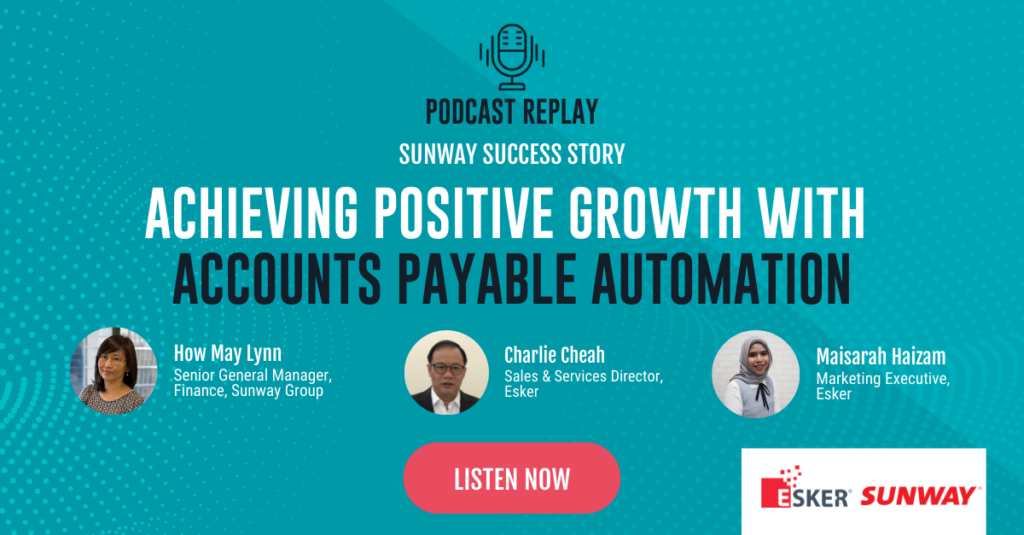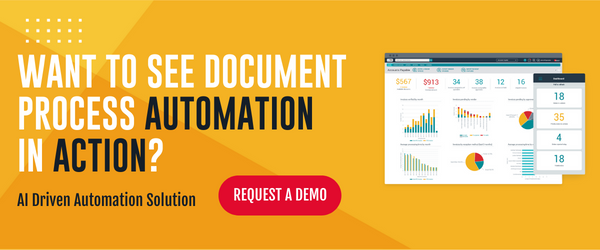
Sunway Group is one of Southeast Asia’s leading conglomerates. With a presence in more than 50 locations worldwide, primarily across the Asian region. Sunway Group comprises 13 business divisions: real estate, construction, retail, hospitality, leisure, healthcare, education, financial and investment services, trading and manufacturing, building materials, quarrying, Real Estate Investment Trust (REIT), and digital. Servicing financial closing processes and accounts payable processes to their in-house business units. Sunway has close to 300 companies under the finance shared services centre arm.
Sunway Group was looking to automate its highly manual invoice management processes to free up its finance shared service centre from time-consuming, low-value tasks and streamline its business processes.
We sat down with How May Lynn, Senior General Manager, Finance from Sunway Group a customer of Esker for 7 years and Charlie Cheah, Director, Sales and Services from Esker Asia. In this podcast, we will be walking you through the digitalisation journey of Sunway inclusive of their challenges and achievements.
1) May Lynn, what was the trigger point for Sunway to start automation?
May Lynn: Way back at the end of 2015, we had a significant need to look into sustainability and value creation, especially from the perspective of ESG. We were looking at a sustainable objective and goals to bring our finance shared services centre towards efficiency, and productivity and to attend to our employee’s workload. We are also very instrumental in measuring our employee’s engagement percentage. Then, the feedback to us was that the work task in the financial shared services centre was a pain point.
From the business units we are servicing, such as the construction business units and the property business units, processes are very manual and mundane. Being in a large group, we have a diversified industry, and our volume of transactions is enormous. For us to be sustainable and to be able to create value, we have to look into digitalisation.
2) Charlie, during this challenging time, how was implementation done at Esker’s end?
Charlie: We feel the pain of the pandemic with the restricted movements. Before the pandemic, most of the feedback, was our customers’ requests for on-site implementation and interactions, typically when we do projects. Thanks to the pandemic, it’s a game-changer by itself. It transformed people’s mindsets, from the lockdown in Malaysia to the recent relaxation; I am happy to share we have projects that were done, from the starting kick-off to implementation go-live was 100% virtual. You do not necessarily need a physical touchpoint for things to work. We have done that very successfully.
Fast track and doing it incremental are equally essential to improve progressively. In the last two years, 100% of our projects were done both remotely and virtually. Some were even faster than previous projects which had on-site elements. That is possible as software is a service where we host software with a platform to minimise the customer to manage IT support and the deployment of requisition on hardware that facilitates the possibility during the pandemic.
3) May Lynn, you mentioned that in 2015, Sunway started automation and was able to automate 80% of the business processes by 2017. What are some of the challenges you were able to solve with automation?
May Lynn: The challenges then, when we were processing documents manually, we had a lot of issues such as missing documents, data entry and visibility. The reason is that suppliers in the construction site submit their delivery orders and invoices to the project site. We will then have to wait for the project site employees to bring back those documents before our processing centre begins keying in the details of the invoices, and then after we can pay the supplier. Having said that, if you can imagine that there’s a massive volume of documents being transferred here and there physically, not only the difficulty of data entry but will also slow down the processes which lead to payment delays. There’s no speed because you are using human capital to key in the data, so a person can only key in at a specific rate and potentially, more errors are made.
We emphasise compliance; SEPA Act talks about paying your suppliers on time. It is vital importance that also drives why we need to automate because we want to be fair to the supplier, to pay them on time, for them also to be able to run their operations and keep meeting win-win objectives between the suppliers and the contractors. The main benefit that we reap right after the construction implementation goes live was call reduction, primarily the supplier calls, because Esker has a dashboard where the supplier can see the invoice status and submit their invoices online.
4) Charlie, can you share with us how will automation support visibility and cost reduction?
Charlie: It’s not just about dollars and cents; ultimately, ROI is beyond the percentage of cost-saving. We always feel that automation does not relate to headcount reduction. At times, there is a lot of value in your current resources, and perhaps we may be in the overwork capacity. By bringing automation, you’re bringing back an equilibrium work environment. Chances are the same set of resources; employees can perform value-added and analytical work rather than data entry or manual paper handling. These are also a form of return on investment, looking at your expenditure, which you can leverage to get better pricing.
I strongly advise that it’s good to build a business case to justify ROI. Still, there are also benefits to be gained from the intangible aspects, such as suppliers’ ease of doing business with you by providing them visibility. Ultimately reducing the supplier cost of doing business means translating to a better cost for you.
5) To share with everyone today, the implementation of automation has a significant impact on people’s development in Sunway. Charlie and May Lynn, can you share a little bit more on this?
Charlie: Esker has a tagline that we call positive-sum growth. So, 1 + 1 does not necessarily equal 2; 1+1 can also be equal to 5. Ultimately the aim of automation brings benefits of efficiency and visibility to the organisation. When we talk about positive-sum growth, we are talking about the stakeholders, suppliers and customers; definitely, that is what we aim to achieve. ROI is a traditional approach, it’s still valid, but there has to be a change of mindset. Automation is not only about dollars and cents from that perspective.
May Lynn: Employees are our asset. We want our employees to be able to develop together with our company. When we automate our business process, we move our employees to perform higher-value tasks. So even when they are learning and developing their personal skills, they feel more valuable in their career. We measured our employee engagement, and right after our automation for P2P, our employee engagement score improved by three folds. We are very thankful and glad that when we started this automation, this was an intangible benefit that we did not foresee.
6) We are curious, May Lynn, you have more than seven years of experience implementing automation, and there are many ways to start a finance automation project. Based on your experience, what are the top focus you advise companies to start with?
May Lynn: As soon as the organisation or the implementation team has set up their business case or business objectives, the next most important aspect is to set up a very calibre team and timelines. In our case, our estate implementation project involves mainly our finance team.
Knowing that our finance team has many reporting timelines and statutory timelines that they have to abide by, we have to be realistic in terms of the timeline we set. We must set stretch goals but an achievable stretch goals. Once you have your goals and objectives ready and have set up a calibre team, have your timeline communicated thoroughly and back it up by your senior management. Work within your budget, so you don’t get overly stressed that your project is not accomplished as your budget is running out. The other key factor is the adoption of change management, change management is very pertinent, and you cannot underestimate it because you are transforming your business processes.
7)May Lynn, you recently shared about decision-making on the top management level and budgeting. Can you share how painful and how long was the implementation period?
May Lynn: If I say how painful it is on a scale of 1 to 10, I would say the first pilot project is a little bit more painful because you have to address every aspect of the full implementation. We must address how our system will integrate with our back-end ERP? What is the information that is going to be flowing through? Because all those controls will still have to be in place, coming up with an efficient flow is a pain point. Bear in mind that when you automate, you wouldn’t want to automate as it is; you have to do some process reengineering to automate.
In our case, it took six months to do our first pilot, and in that pilot, we did two industries—six months for two major industries with the highest volume of invoices. We roll out immediately right after month six. After month six rolled out, there was still a little fine-tuning, not so much on the system but the people management and the change management. They are not used to looking at the dashboard and pulling out the soft copy invoices. They do not have a comfort level yet in using the system at that point in time.
8) May Lynn, can you share about the resistance from users on the new solution adoption and the risk of losing jobs in other words, job insecurity?
May Lynn: This is where the top management involvement is critical because top management for Sunway, I think from the start when our top management got involved in such automation projects, the assurance is that we are not going to make employees leave their job. We’re going to leave employees’ job experience and job knowledge. How we do it in Sunway is we have the advantage of so many business units within the group, so we redeploy our finance shared services finance employees to the business units. That’s how we assure them.
9) May Lynn and Charlie, last words from both of you before we close the session?
May Lynn: I must say that having walked this evolution or automation journey, if you ask me how would I have done it any differently back in 2015, I would think only a few areas that we will probably fine-tune a little bit. We are so happy that our processes now are fully automated. Our employees’ feedback to us was they were all initially fearful. Still, having seen the processes being fully automated, they can’t wait to walk into the office every day and enjoy doing just a procure-to-pay task. They are less clerical because they have evolved to look into the efficiency of businesses. It enriches our employee’s jobs; rather than just keying in invoice data, they talk to suppliers and grow their job proposition. I wouldn’t go back in time, I wished I’d done it earlier.
Charlie: Definitely, Sunway has been at the forefront, making a lot of impact in the construction sector, thankyou May Lynn for sharing with us your experience.
Today, Sunway Group has achieved efficiency, productivity, supplier and employee satisfaction in the financial shared services centre with Esker’s Accounts Payable Solution. Read more about Sunway’s success with Esker’s Accounts payable in this case study.
-Written by, Esker Admin


